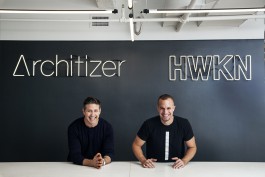



An interview with architects Matthias Hollwich and Marc Kushner, New York City, about visual identity, authenticity in residential design and timeless ideas.
Matthias Hollwich, Marc Kushner, as a German-American partnership you founded HWKN studio in New York City. How far do these different backgrounds influence your work?
Marc Kushner: Our backgrounds are wildly different and we have found that there is a natural tension behind how we approach an architectural challenge. That tension is what we think is the ‘magic’ ingredient in our work. I am formal where Matthias is analytical. I like gold. Matthias likes black. I like the Pixies, Matthias likes Rammstein. What we both agree on is that architecture needs to be consumable by the broad public. Our process includes us challenging, competing, convincing, until the best idea wins and more often than not, it is a hybrid of both of our thoughts.



Your projects are visually very strong. How important is a strong individuality for a piece of architecture to cause impact on the city, also in the long run?
Marc Kushner: Visual identity is a huge asset that architects have to communicate to the public. We strive to take full advantage of that, especially in a world with nearly two billion smart phones taking over a trillion pictures every year! With that said, we work hard to create buildings that are visually shocking today, but designed to fit into their site condition for the decades and centuries that they will be around for. A building is always shocking when it arrives in a city. We love that, but we also create buildings around timeless ideas of place making. That is what makes them enduring long after the visual shock wears off.
Matthias Hollwich: Everyone of our project is based on three principals. 1. Absorb location qualities, 2. Introduce social qualities, 3. Shape into a recognizable form. Since visual form is part of an integrate strategy the visual expression has longevity and will instantly become part of the local fabric.


How far does this perspective on uniqueness correspond to changing lifestyles also in a more private sense? In which way do today's lifestyles ask for new forms of architecture for the places we frequent the most in our daily lives, like residential spaces?
Matthias Hollwich: Our world is more diverse than ever and the opportunity of personal expression is key, but it does not require that every apartment is different. The key is that it is authenticity. Homes and buildings aren’t products; they are investments into long-term values for people and their neighborhoods.
A part of your work is connected to the field of branding. Could you describe your cooperation with companies a bit?
Matthias Hollwich: Whenever we work with a brand or agency we clarify that we are an architectural firm that treats any installation like we would a building – identifying contextual qualities, structure integrity and quality detailing. This is what makes our brand related work different to pure marketing exercises.
Profil
Matthias Hollwich, born in Munich in 1971, and Marc Kushner, born in New Jersey in 1977, founded their architecture firm HWKN in New York in 2007. The aim of HWKN's work is to merge individual personality, local context and highly social experiences ‘to facilitate those unique emotional bonds that form between people and their built environment’. Projects by HWKN have been published in the US and Europe and Hollwich and Kushner have lectured extensively. During the 2008 Global Financial Crisis they created Architizer, a digital platform to help architects promote their firms' work.
www.hwkn.com
